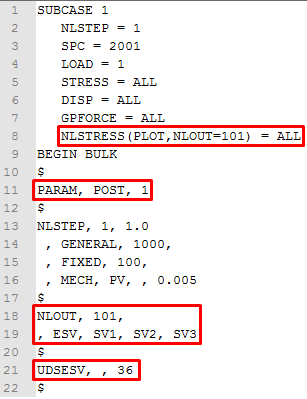Use a text editor to request output of the MCT state variables.
Solution-dependent MCT state variables track the history of certain quantities computed in the Simulation Composite Analysis User-Defined Material Subroutine. These MCT state variables are not written to the output file unless explicitly requested in the bulk data file. Use the NLOUT entry to request MCT state variable output in the bulk data file. Consider the example below:
NLOUT, 101, , ESV, SV1, SV2, SV10, SV11, SV12
The NLOUT entry specifies the additional nonlinear output quantities referenced by the NLSTRESS case control command in SOL 400. Here we have given the NLOUT entry the identification number of 101 and requested output of the user state variables (ESV) SV1, SV2, SV10, SV11, and SV12.
UDSESV
UDSESV, , 36will set the number of state variables to 36 for all user materials, thus allowing us to potentially request output up to SV36. Be aware that MSC Nastran only allows nine fields per line.
- Unidirectional or woven material with Instantaneous Degradation - 8
- Unidirectional or woven material with Energy Based Degradation - 12
- Unidirectional material with output of constituent stress/strain data - 36
- Woven material with output of constituent stress/strain data - 91
- Cohesive material - 10
The example below demonstrates how to use the NLSTRESS, NLOUT, and UDSESV entries to request output of all nonlinear stresses and user state variables 1-3. To view these outputs in Patran you must also use the PARAM entry.
